
|   |

|   |
 e-mail: leelakaverivenkat@gmail.com SPIC MACAY Convention with JNU collaboration centre stages multi- flavoured exercise as meditative not entertaining Pics: Anish Mishra July 12, 2019 A fruitful collaboration saw SPIC MACAY's seventh International Convention simultaneously celebrating the Golden Jubilee of Jawaharlal Nehru University. Even as the torrid summer heat sapped energies, JNU hosted the week-long event on its spacious grounds. For SPIC MACAY's founder Dr.Kiran Seth, braving forty years, surmounting financial and organizational bottlenecks, armed with just total commitment and faith, that the right cause with 'Nishkama Seva' will keep the flame burning despite impediments, destiny this year ensured the collaboration of Prof. M. Jagadesh Kumar, Vice Chancellor JNU, who, including the concluding all-night program from 8pm to 6.30am, was present right through with his wife. 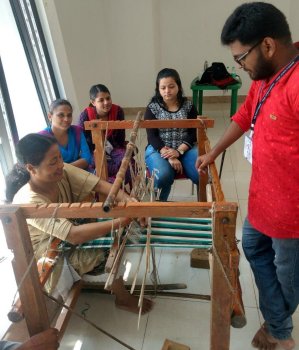 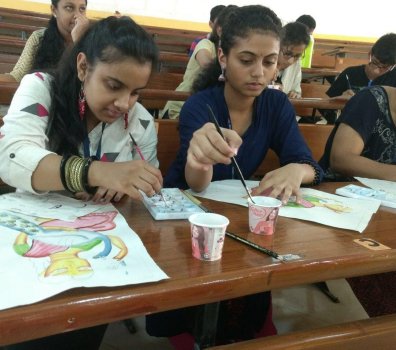 While eloquently intoning about 'spirituality' in our arts, the increasing trend making everything a spectacle, has robbed arts of that attentive listening, creating that inner silence, which in equanimity has an ecstasy. Spiritual traditions have to be experienced for that quiet spaciousness within each one of us to be felt. SPIC MACAY's supreme contribution lies in trying to tether impetuous, restless young minds by providing, not high power entertainment (of which there is plenty) but a total Indian experience integrating Yoga, meditation, music, dance, theatre, painting, folk art and crafts, screening of epoch making films with interactions with writers and actors, and workshops conducted by top artistes - helping evolve an understanding of the assimilative Indian identity sans dogma, in myriad flavours. It was extremely encouraging experiencing over 1200 youngsters from all parts of India, squeezed into an auditorium normally seating 400 people (!), maintaining an attentive silence, refraining from loud ovations or claps, taking in all forms of art. A week of rising in the wee hours of 'brahma muhoortam' at 3.30am, with a day filled with activities till 11pm with only cat naps of 'yoganidra' in between, the convention was a unique exposure to the mystical core of the Indian experience. One saw 'Madrasis' from the South, who when asked their names said that they could not understand Hindi, joining Sattriya workshop of Guru Ghanakanta Bora and thoroughly enjoying it! A young lecturer from an Engineering College in Kharagpur gamely trying to engage with Kathak movement in an intensive said, "I want to have that experience and know what it is." Fighting the weather, performing in non air-conditioned classrooms, Bharatanatyam learners hailing from all corners of India, in Saroja Vaidyanathan's intensive, performed a swarawali, in stupefying synchronization! Geetanjali Lal's Kathak intensive saw aspirants writing down bandishes with notations. Guru Munna Shukla, alongside the 'ta thai tai tat' introduced youngsters to myriad hand movements interpreting 'Panchabhoota.' Kavita Dwibedi's intensive introduced beginners to the central Odissi concerns of tribhanga, chowka with a Vighneswara invocation. Rani Khanam tried some basic abhinaya, given her group of mixed proficiency. Involved youngsters in Sudha Raghuraman's intensive perfected a Balamurali Krishna Varnam in Gambheera Nattai and a Dayanand Saraswati composition in Yamuna Kalyani and in Sarathi Chatterjee's intensive, one heard sur filled singing by a large group. A North Indian couple, dumb struck after an exposure to Kapila Venu's Koodiyattam kept repeating, "We never knew such an art form existed. Kamaal hai!" For many youngsters and adults, this week long convention proved a primary look at the entirety of India. 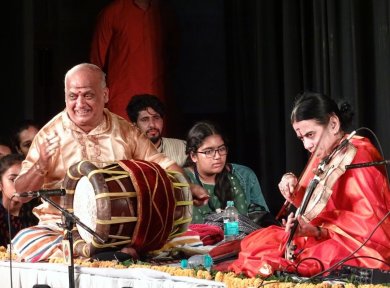 A.Kanyakumari 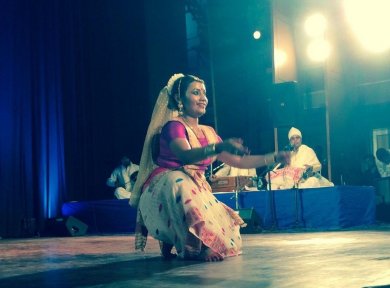 Anwesa Mahanta Coming across so many eminent people from various spheres compels the realization of how many great men and women have variously contributed to the country! Acknowledging this truth is the Shree ragam Pancharatna Keertanam "Endaro mahanubhavulu" by inimitable composer/musician Tyagaraja. Carnatic violinist A. Kanyakumari, epitome of modesty, accompanied by disciple Sai Rakshi, presented this very Keertanam, the solfa passages before each sahitya sequence robustly suited for the Tavil percussion (Triplicane Shankar) and Kanjira (Aniruddha Atreya), engaging the full attention of students. The zippy Hamsadhwani start with "Vatapi ganapatim" and Tillana in Sindhubhairavi also had a rhythmic gait finding quick response in the young. Soft touches with raga improvisations came in Tygaraja's 'Inta Sowkhyamu' in Kapi, with fleeting glimpses of Hindolam, Shahana etc and finally came the melodious Yamuna Kalyani "Krishna nee begane baro." If violin accompanied by Tavil catered to youthful taste, Ustad Amjad Ali Khan's sarod recital sported two accompanists on tabla, while an episodic reminiscence pre-empted his main Durbari Kanada, of how his father and Guru Ustad Hafiz Ali Khan, on the occasion of being conferred the Padma Bhushan was introduced to the President Dr. Rajendra Prasad, who enquired what he could do for him. The Ustad replied that he wanted nothing but preservation in its purity of Durbari Kanada, created by Miya Tansen in the 15th century, rescued from dilution through liberties of present-day artistes! The sarod maestro's rendition of Durga was preluded by 'Pahadi Durga,' Durga used in Assam's Bihu dance and Tagore's 'Ekla Chalo', before presenting the full- blown classical version. While this, for some diehards watered down classicism, it is also significant to educate youngsters on how classical ragas are often stylized versions of folk originals. 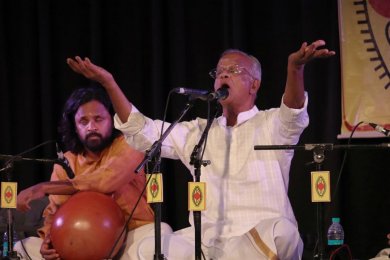 T.V. Shankaranarayanan 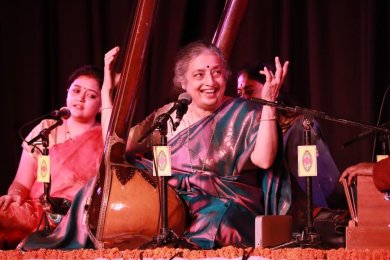 Ashwini Bhide Deshpande Music recitals radiated the feel of interacting with a higher consciousness, as in Pandit Rajan-Sajan Misra's savoured, step by step Khayal alaap in raga Shree, as also the Chota khayal with the Ramadasa composition, concluding with the Bhajan saluting the teacher - "Guru sadhu aise hi guru pave, Raag ranga kabhar bhar pyala pive aur pilaave". The musical vigor combining negation of the Self characterized T.V. Shankaranarayanan's salutation, seeking the deity Vazhangadi Mahaganapati through his own Hindolam composition, in search of inner peace. The Kalyani centerpiece bristling with commanding virtuosity and briskness of improvised swara passages, the quivering emotion of a Papanasam Sivan Virutham evoking Guruvayurappa in Chakravakam or Tygaraja's "Nagumomu ganaleni" in Abheri, or the yearning appeal of the Jonepuri "Eppo Varuvaro", were all laced with that feel of addressing a higher presence. So too was the trilling intensity of Khayal in Ashwini Bhide Deshpande's Jhinjhoti "Maha deva Shankara" like an aradhana in the vilambit in Jhaptal (drut in teeental was in Tarana). An aesthetic contrast with "Papihara" in Miya Malhar and finale with the deep philosophy of a Kabir bhajan "Chadar ho gayi bahut purani" was in character. 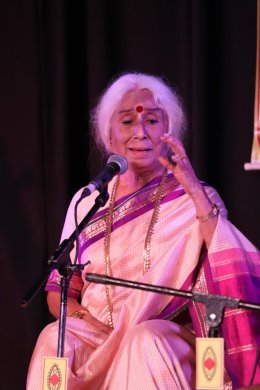 Prabha Atre 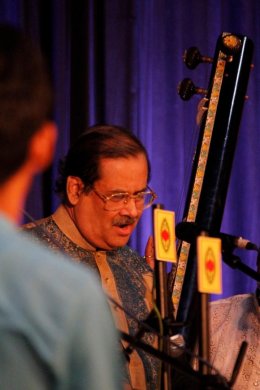 Ajay Chakraborty The gravitas and command in Prabha Atre's Khayal rendition of Jog Kauns and her Bageshree, Kaushik Ranjani showed up the grandeur of India's classical music to listeners. As for Ustad Shahid Parveen Khan's sitar, the leisurely alaap treatment (rare today) in Rageshri seemed to speak to the listener's inside and the piercingly melodious Piloo had the audience in raptures. SPIC MACAY's encouragement of rare instruments like the RudraVeena played by Ustad Bahaudin Dagar was like a deep prayer in the aalap in Yaman, basking in the mandara sthayi alone for over half an hour. 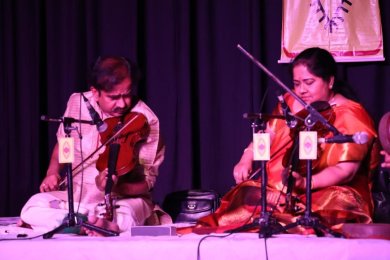 GJR Krishnan, Vijayalakshmi 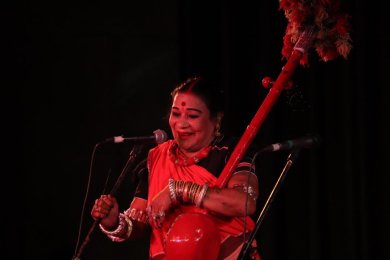 Teejan Bai The equivalent of the 'Gayaki ang', the appreciation for the violin playing duo Lalgudi GJR Krishnan and Lalgudi Vijayalakshmi, direct inheritors of the legacy of their esteemed father late Lalgudi Jayaraman, hearteningly revealed non-south Indians becoming more open to Carnatic classical. Starting with the Shyama Sastry "Marivere" in Anandabhaiavi followed by Tygaraja's "Manavinaala kincha" in Nalinakanti, "Teeraada vilaiyaatu pillai" followed by Sadashiv Brahmendra's composition in Sama, and Tillana in Desh was the ragam, tanam with Pallavi in Hamsanandi "Swagatam Shubha Swagatam" - and all this at 3am in the morning, after the duo had just landed from an American tour! From Sufiana Qawwalis by the Warsi Brothers of Hyderabad to Bhai Manohar Singh's reposeful cogently introduced Gurbani compositions, from Capital City Minstrels presenting traditional and contemporary creations to Buddhist meditation by Drikung Kagyu Shachukul Monastery Monks, music-in-prayer presented an incredible range. Rural-urban divides ceased to exist, as students paid obeisance to artistes like Teejan Bai of Pandvani (pandva-vani of the Pandavas), whose absence of formal literacy posed no hindrances in imaginative mentoring, her intensive aspirants encouraged to speak in Hindi and not her Madhya Pradesh dialect. Tribal art too had its representation in Gusadi Dance from Telengana, dancers resplendent in exotic peacock feather-adorned massive headdresses dancing to the drone pipe accompaniment, in a variety of steps for over an hour! Dadi Pudumjee's talk with demonstration of inanimate objects and dolls, through the puppeteer's manipulations, becoming characters evoking that suspension of disbelief, had the most avid listeners. Krishen Khanna's talk on Modern painting with some visuals of his coveted work screened, astonished with the clear thinking introspections of a 94 year old confined to the wheelchair but with a still razor sharp mind, explaining how the Progressive Art Movement believes in no structured work, for as one applies brush to a surface, the expanding work assumes its own logic and begins to say something. He showed visuals of his work on the Maurya Hotel phony Dome where he set off with no preconceived idea. Soon from shades of the Last Supper to Power represented in Military Trucks, it became a collage of emotions on Earth and in the Universe, with animals, people, mountains and what have you. The compulsion to paint, acts as the driving force. 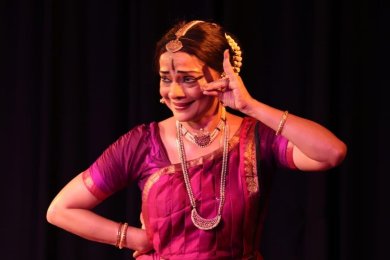 Malavika Sarukkai 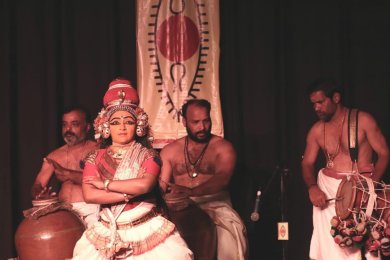 Kapila Venu Dancing as if possessed, Malavika Sarukkai had the overfilled auditorium spellbound, notwithstanding the inexplicably long wait before she made her entry after announcement. The majesty of her Shiva depiction as 'Parama dayakara' 'mrigadhara' Gangadhara, based on Tyagaraja's composition in Pantuvarali "Shambho Mahadeva" was followed by the grace and dignity of Devi as visualized in the Neelambari "Sringaralahiri". Captivatingly varied responses, human and non-human to 'Maulischandrika' Krishna entering Mathura, based on Krishna Karnamritam verses sung in ragamalika, evoked overwhelming moods of desire, wonder and charm. The Balamurali Tillana in Brindavani ushered the conclusion with "Vande mataram". Murali Parthasarathy's moving vocal support along with a fine music team of instrumentalists, not omitting Malavika's passionately involved introductions made the evening unique. Kapila Venu's Koodiyattam wizardry in mapping of facial expressions with the mizhavu percussion, visualized 'Parvati Viraham.' Parvati's suspicious queries concerning Ganga lodged in Shiva's locks, prompting Shiva's evasively trivializing explanations had confused Parvati leaving in a jealous tizzy - till Mt Kailash her home, arrogantly lifted by Ravana, starts shaking, sending her scurrying back to Shiva for comfort. It was a rare interacting session with Rajat Kapur, winner of the Best Actor award for the "Making of the Mahatma" in 1996, along with Pallavi Joshi who plays Kasturba. The absorbing film, living up to the challenge of so persuasively fleshing out roles of persons so familiar to our times, while revealing the inner workings of the Mahatma's mind also raised questions about the sacrifices demanded of his wife and family, in fulfilling his goals. How did Kasturba, who in dry humor mentions at one point that having survived marriage with Mohandas, nothing is beyond her, feel about her life? The film is a must see for all Indians! A marathon effort pulled off yet again!  Writing on the dance scene for the last forty years, Leela Venkataraman's incisive comments on performances of all dance forms, participation in dance discussions both in India and abroad, and as a regular contributor to Hindu Friday Review, journals like Sruti and Nartanam, makes her voice respected for its balanced critiquing. She is the author of several books like Indian Classical dance: Tradition in Transition, Classical Dance in India and Indian Classical dance: The Renaissance and Beyond. Post your comments Please provide your name and email id when you use the Anonymous profile in the blog to post a comment. All appropriate comments posted with name & email id in the blog will also be featured in the site. |